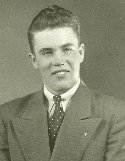
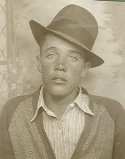 On a blustery winter day seventy-one years ago, I was delivered into this world. The delivery was assisted by two elderly midwives who took care of the health needs of the community. The event took place on February 21, 1925 in an isolated ranching community that is located in the extreme northwest section of the state of Utah. The location of the community, called Grouse Creek, is within ten miles of the Idaho and Nevada border. At that time, access to this community was almost exclusively by railroad, via Lucin, Utah, and mail
On a blustery winter day seventy-one years ago, I was delivered into this world. The delivery was assisted by two elderly midwives who took care of the health needs of the community. The event took place on February 21, 1925 in an isolated ranching community that is located in the extreme northwest section of the state of Utah. The location of the community, called Grouse Creek, is within ten miles of the Idaho and Nevada border. At that time, access to this community was almost exclusively by railroad, via Lucin, Utah, and mail

Alta, Flora, Wayne and Lewis Tanner
carrier transportation, consisting of horse and buggy, and vintage automobile.
The isolation of the community has many advantages, which probably offset the disadvantages. Isolation forced the inhabitants to rely upon one another for recreational, medicinal, emotional, and social outlets. It also created a community of close knit family and neighbor ties.

Grouse Creek School-1935 Front Row: Claire Warburton, Marjorie Tanner, Reese Warburton, Olene Ballingham, Verl Toyn
2nd Row: Neal Warburton, Lavon Richins, Dorothy Kimber, Venice Carson, Wendell Ballingham, Wayne Tanner, Arthur Paskett, Morgan Roberts
3rd Row: Edward Frost, Evva Lee, Virginia Warburton, Velma Kimber, Wilda Frost, Kay Kimber, Max Hadfield
4th Row: Miss Madsen, Douglas Richins, Viril Kimber, Barbara Kimber, Emma Paskett, Marie Roberts, Max Tanner, Clifton Kimber
Mine was a happy childhood with remembrances of large family dinners, holiday celebrations, and rare visits by school and church officials. Our family life was (and still is) one of closeness and compassion for one another. The ranch life required a dependence upon one another and yet taught a certain amount of individualism concurrent with time and place.
The school was extremely small by the standards of modern consolidation; yet to a small boy used only to infrequent visitors, it was a rewarding experience eagerly awaited each day even though it sometimes required a mile trudge through waist-deep snow banks.
The school had three teachers who taught grades one through ten, with the average of five to twelve students per grade. The small numbers in each grade enabled the teachers to give a large amount of individual attention and help to each student. The individual attention probably helped me to like school.
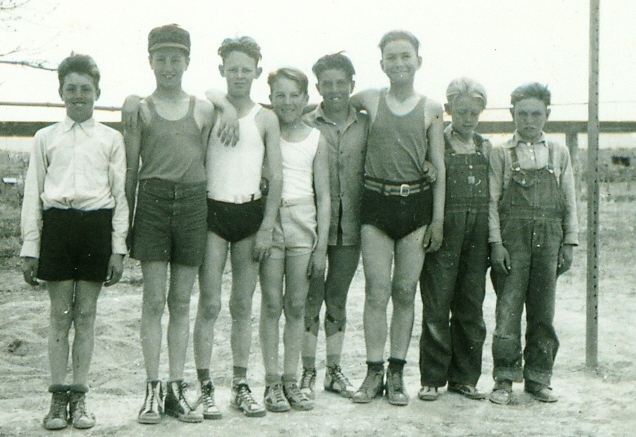
Bob Warburton, Gerald Warburton, Edward Frost. Olene Ballingham, Wayne Tanner, Arthur Paskett, Max Frost & Lewis Tanner
With the completion of the tenth grade in this community, one had to choose between dropping out of school or boarding out in one of the large towns of the county in order to complete his education. It was my good fortune to be allowed to continue my education at Box Elder High School in Brigham City, Utah.
I was accepted well by the student body at Box Elder, even though I probably appeared to them as a backwoods country hick. I had never seen a football game, yet with a little determination, I made the team the first year and was lucky to be allowed to play in a state championship game. What a thrill for a small town boy!
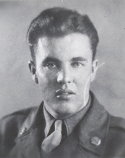 Graduation exercises in May 1943 awarded me a high school diploma. It also marked another milestone in my life. One week after graduation, I was inducted into the Armed Forces of the United States at Fort Douglas, Utah. Two weeks later I arrived at Camp Callon, California to begin Officers Candidate Preparatory School. Near the end of my training, a directive came through Command stating there was no longer a need for artillery officers. I was transferred to Fort Bliss, Texas as a radioman. I applied to the Army Air Force for training as an Air Force Cadet and was accepted. During initial training as an Air Cadet at Shepard Field, Texas, a directive came stating that all ground forces in the training program would be transferred back to their old units. My old unit had been deactivated and I was transferred to the 75th Infantry Division at Fort Breckenridge, Kentucky. This was preparatory to being shipped overseas into combat. October 1944 found me in Wales in a staging area preparing for a landing at Le Harve, France. On New Year’s Day of 1945, I received baptismal fire in the Battle of the Bulge in the Ardennes Forest in Belgium. Our unit relieved the 106th Infantry Division and parts of the 101st Air Borne Division at Bastogne, Belgium.
Graduation exercises in May 1943 awarded me a high school diploma. It also marked another milestone in my life. One week after graduation, I was inducted into the Armed Forces of the United States at Fort Douglas, Utah. Two weeks later I arrived at Camp Callon, California to begin Officers Candidate Preparatory School. Near the end of my training, a directive came through Command stating there was no longer a need for artillery officers. I was transferred to Fort Bliss, Texas as a radioman. I applied to the Army Air Force for training as an Air Force Cadet and was accepted. During initial training as an Air Cadet at Shepard Field, Texas, a directive came stating that all ground forces in the training program would be transferred back to their old units. My old unit had been deactivated and I was transferred to the 75th Infantry Division at Fort Breckenridge, Kentucky. This was preparatory to being shipped overseas into combat. October 1944 found me in Wales in a staging area preparing for a landing at Le Harve, France. On New Year’s Day of 1945, I received baptismal fire in the Battle of the Bulge in the Ardennes Forest in Belgium. Our unit relieved the 106th Infantry Division and parts of the 101st Air Borne Division at Bastogne, Belgium.
The 106th Infantry Division had lost two-thirds of its men in combat. The remaining men wandered into our message center for many days after we had relieved them of duty. It was at this time and place that the realization of need for compassion and understanding struck me. Men would come in completely uncognitive of their identity or their whereabouts. This experience was very eye-opening to a young nineteen year old. Witnessing men break under stress of battle and fatigue, as well as the witnessing of some men becoming stronger in stressful situations, had tremendous impact upon me. I feel this experience caused me to have better understanding and empathy for my fellow man.
Luckily I survived World War II without injury. I sailed back into New York Harbor on my 21st birthday. The sight of the Statue of Liberty was indeed a welcoming site as well as a tremendous birthday present.
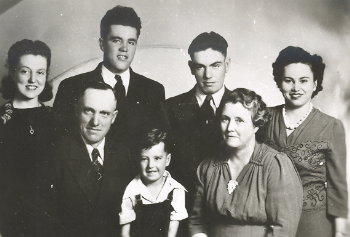
Flora, Wayne, Lewis, Alta, Ray, Harvey & Sarah Tanner
My father convinced me to work with him on the cattle-ranch after I had received my honorable discharge from the Army. I remained with my folks on the ranch for seven years. Being self-employed is quite different from being employed by someone else, and the shifting of roles is sometimes quite extensive.
In 1953, Sharon Rose and I were united in marriage at Standrod, Idaho. Her father was a sheep man with no son so Sharon and I helped him for two years.
I was offered employment with Swift and Company in Ogden, Utah. We accepted the employment and moved to Ogden in September 1955.
In September 1961, my wife decided to go back to school. During her second year of school, I began taking one class per quarter with her. We agreed that she would receive her degree as soon as possible and then I would become a full-time student.
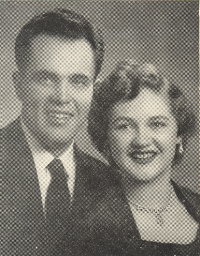
Wayne & Sharon Tanner
Sharon became interested in social work and was accepted to the Graduate School of Social Work at the University of Utah. The discussion of classes with her, the reading of her texts, the interaction with students and faculty on campus, and the interest in human behavior, finalized my decision to choose Sociology (Social Work Sequence) as my major.
I had done several research projects for Anthropology classes in the area of subculture, adoption, foster care, and drunkenness of different subculture. These studies helped to make my decision more concrete.
I always felt I could relate well with people, particularly with the older citizens in our society. The decision to choose social work is the result of many factors; the close proximity of my life’s partner and her professions (Psychiatric Social Work), my compassion for the troubled in our society, the overview of life that experience has given me, and my desire to be of some help to my fellow man.
During my final quarter at Weber State College in 1968 I was accepted into the Graduate School at the University of Utah. My two years in training there saw me the first year at the Administrative Office of Juvenile Courts forUtah and the second year was at the Utah State Division of Mental Health.
I graduated in 1971 from the Graduate School of Social Work, and my first and only child was born on September 29, 1971. We named her Melanie Grace. These two things were thrills to a forty-six-year-old man.
Social work jobs were not too plentiful in 1971, so I continued to work at the Utah Dept. of Transportation. In 1973, I went to work for the Ogden Area Community Action Agency as their planner. I assisted in developing Head Start, Programs for the Black, Elderly, and the Migrant Health Council. In 1974, I went to Weber State College, School of Allied Health Sciences. Some of the projects and programs I helped to develop while at the School of Allied Health Sciences were:
- Rural Health Project: A study of health care in the sixteen rural hospitals in Utah.
- Geriaide Project: A training program for nurse aides to certify and provide care in nursing home. It was eventually adopted and used in all fifty states.
- The Paramedic Training Program: A training program for Emergency Medical Technicians to become Paramedics. This was the first Paramedic training program in the Intermountain area.
- Dental Hygiene Program: A program to train dental hygienists.
- Bachelor Degree Program in Allied Health Sciences: A program to allow students to get a Bachelor’s Degree in Allied Health Sciences.
In 1979 I moved from the School of Allied Sciences to the Department of Sociology, Social Work, Anthropology and Gerontology. I was an instructor in Gerontology and was the first faculty member in Utah to become certified in Gerontology. I taught a course in Gerontology and was a coordinator of Field Practicum in Social work and Gerontology.
One of the most traumatic experiences of my life was on March 2, 1983, when I was divorced. From 1978 to 1988 I was a Social Work Consultant in six nursing home facilities, Administrator of three nursing home, two geriatric facilities, and one mentally retarded facility.
Some of the workshops developed by me and offered throughout the State of Utah were:
- Death and Dying
- Depression in the Older Person
- Quality of Life in Later Life
- Retirement
- Losses and Loneliness
- The Care giver for the Alzheimer’s Patient
- Pre-hospital Care and the Senior Citizen
- Working with Family Members Who Have Relatives in Nursing Homes
- Developing a Hospice Program
- Developing a Paramedic Program.
I was the first President of the Hospice of Northern Utah, Chairman of the Board of Aging and Volunteer Services for Weber and Morgan Counties, Member of the Weber County Board of Aging, Assisted in development of Meals on Wheels for Weber Co., Vice-Chairman of Weber County Mental Health Association to assist in development and monitoring of Mental Health Care in Weber County, President of National Association of Social Workers, Weber Co., Branch; Served on National Committee for Long-term care for the National Department of Health, Education and Welfare; Assisted in the development of a task force that was formed to monitor and promote assistance in Child Abuse.
In 1989, I had a severe heart attack that restricted my activity and forced me to retire early. In 1991, I developed Brittle diabetes that has further curtailed my activity and changed my lifestyle.
My beautiful daughter, Melanie, has been a joy in my life. She was married on June 17, 1995 to Tim Dalton at Jackson Hole, Wyoming, where they reside. This was the highlight of my life.
- Some of the other highlights of my life were:
- Trips to Washington, D.C. (both business and pleasure) from 1974 to 1983.
- Meetings with Senator Moss and Representative Lawrence Burton in their Washington, D.C. offices in 1976.
- Meeting with Representative Gunn Mackay in his Washington, D.C. office in 1978.
- A cruise to Mexico aboard the T.S.S. Fairsea in April 1976.
- Attended the inaugural of President Ronald Reagan in 1980 and attended the reception in the Senate office building given by Senator Garn and Hatch.
- Attended the N.B.A. Eastern Division Championship game between the Boston Celtics and the Detroit Pistons on May 30, 1987, in the world famous Boston Gardens. My brother, Harvey, and I had seats at center court and front row for the game.
I have made peace with myself and others with a hope to live my last years happy, growing a few roses, flowers, and particularly tomatoes.
I asked my mortician the other day if he was ready for me. He said he was very busy and could I wait awhile. So, I guess I’ll have to sit and watch the world go by until the mortician can find time for me.
Written and submitted by Wayne R. Tanner – June 1, 1996
Wayne spent a happy Christmas with his daughter, Melanie and son-in-law Tim Dalton at Tim’s father’s home in Chicago. After returning home he suffered a heart attack and passed away on January 5, 1997 at Mckay Dee Hospital. He was interred in the Washington Heights Memorial Park in Ogden.
